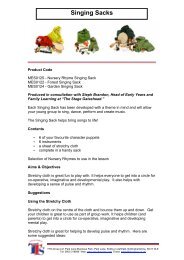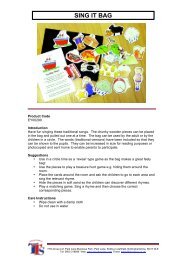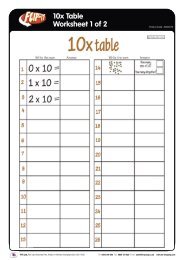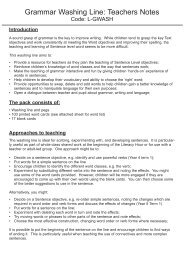Create successful ePaper yourself
Turn your PDF publications into a flip-book with our unique Google optimized e-Paper software.
<strong>Roman</strong> <strong>Coins</strong>Code: R-COINSet 1: The Invasion of BritainDenarius of CaesarGold Stater of CatuvellauniAt the time of the invasion, the basic pay ofa legionary soldier was about five denarii aweek. A <strong>Roman</strong> Centurion would have beenpaid about seventy denarii per week. Hewould have been paid in silver like theDenarius of Caesar.Set 2: The <strong>Roman</strong>s in BritainDenarius of VespasianAureus of DomitianAureus of DomitianDomitian, younger son of Vespasian, continued hisfather’s policy of attempting to conquer the whole ofBritain. Agricola, Goverener at the time, led the <strong>Roman</strong>army at least as far north as Inverness. The coin, a goldaureus, shows a cornucopia (horn of plenty) reflecting theprosperity of the time.Set 3: Military Campaigns & RebellionSestertius of NeroDenarius of TitanDENARIUS OF CAESARJulius Ceasar, never an emporer, was a dictator of Rome.He made two military expeditions to Britain but withdreweach time. In 55BC he landed with two legions in Kent butquickly returned to Gaul (France). In 54BC he again landed,this time with five legions and 2000 cavalry, and succeededin crossing the Thames before withdrawing. The front ofour coin, a silver denarius, depicts an elephant and serpentrepresenting Caesar’s achievement - The conquest of Gaul.The reverse illustrates sacrificial implements publicising hisoffice as Chief Priest (ponifex maximus).GOLD STATER OF CATUVELLAUNI BC45–20At the point of Caesar’s foray into Britain in 55BC, the countrywas split into areas ruled by various Celtic tribes, such asCatuvellauni. Some of these tribes put up strong resistanceto <strong>Roman</strong> forces. The gold coin bears a horse on thereverse and a decayed wreath from a bust on the obverse.DENARIUS OF VESPASIANVespasian served as a legate to the second LegionAugusta during the campaign in Britain of the EmporerClaudius in AD43 and later. Charges with the conquest ofSouth West Britain, he pushed west conquering the Isle ofWight and such warlike tribes as the Durotrigues of Dorsetin their well fortified hill–forts of Maiden Castle and Hod Hill.By AD51 the achievements of Vespasian had caused him tobe elected consul at Rome and won him the respect of thearmy, so much so that in AD69 he was proclaimed emperorby the troops in Egypt. It was under his rule that the<strong>Roman</strong>s conquered Wales and established legionaryfortresses at Caerleon, Chester and York. Our coin is aSilver Denarius, the reverse showing Vespasian’s sons,Domitian and Titus.SESTERTIUS OF NERODuring Nero’s reign Boudicca, Queen of the Iceni tribe inEast Anglia, led her famous rebellion. Following the death ofher husband, King Pratsutagus, the <strong>Roman</strong>s decided to takethe tribal territory for themselves in spite of the late king havingwilled his kingdom jointly to his two daughters and theemperor. The <strong>Roman</strong>s were extremely brutal, forcingBoudicca to lead her tribe and the neighbouring Trinovantesin revolt against Colchester and then to London. Both Citieswere burned and the people massacred before the rebelsturned north to engulf St. Albans. Suetonius Paulinus,<strong>Roman</strong> governor, led two legions to crush the rebellion. It issaid that 80,000 Britons died to 800 <strong>Roman</strong>s. Boudiccaescaped only to take poison. The rebellion was over.On the reverse of this coin Nero reinforces his militarystrength by picturing himself and a soldier on horseback in“decursio” or combat.DENARIUS OF TITUSTitus was the son of the Emperor Vespasian. Wales and theSouth West of Britain were conquered during his rule. Thereverse of this coin shows an eagle. This was usuallyassociated with a dead emperor being taken to heaven. AsTitus was still alive, the deification was to his father.
Set 4: The <strong>Roman</strong> OccupationAS of ClaudiusAureas ofClaudiusDupondius ofHadrianThe <strong>Roman</strong>s invaded Britain in 43AD when about 40,000 troops crossedthe channel under the command of Aulus Plautius. Claudius himself arrivedin Britain to take command of the later stages of the campaign and earn anofficial triumph.Throughout the <strong>Roman</strong> occupation of Britain the <strong>Roman</strong>s were responsiblefor building many monuments, cities and roads, some of which can still beseen today. The road network constructed was first laid out to support thelines of military advance across England. Wales and finally Scotland. Theroads were very straight and continually needed repairing. This proved tobe very expensive and so the <strong>Roman</strong>s continued to manoeuvre large heavyloads over long distances by water whenever possible. This road networkalso enabled provisions and supplies to be moved quickly and efficiently.Consequently many settlements, villages and civitas (capital cities) grew. Inthe civitas many public buildings were built such as forums, bath housesand amphitheatres. Examples of these <strong>Roman</strong> remains can be seen todaylike the <strong>Roman</strong> Theatre in St. Albans (Verulamium). Shops were alwaysnumerous in the centre of a settlement like a market, providing services forthe towns own inhabitants and neighbouring countryside. Butchers, winemerchants and blacksmiths were commonplace.Hadrian became Emperor in 117AD after the death of Trajan and set about implementing significant changes which marked a turningpoint in both <strong>Roman</strong> and European history. His new policy aimed to consolidate the frontiers and restore order which was in itselfdifficult for there were many who questioned Hadrian’s succession as, during the second century, emperors nominated their ownsuccessors. There were suspicions that Trajan had not named Hadrian, causing discontent among the late emperor’s senior generals.An alleged conspiracy was promptly quashed by the senate ordering the execution of those involved.Evidence of Hadrian’s strengthening and consolidation can be seen between Wallsend and the river Tyne to Bowness on the Solway.Hadrian’s Wall took fifteen years to complete, spanning some 73 miles. and was approximately 10 foot wide and 15 foot high. Thisfortified frontier had fortresses at regular intervals. Between the forts were Mile Castles (fortified turrets). Substantial remains can stillbe seen including forts at Chesters, Housesteads, Carvoran and Birdoswald. Whether used as a barrier intended to control the nativepopulation or as a lasting memorial to Rome’s most northerly point, Hadrian’s Wall is regarded as one of the finest examples ofachievement and has provided historians with an abundance of evidence enabling us to have a clear understanding of the <strong>Roman</strong>occupation.ROMAN COINS AS NEWSPAPERS<strong>Roman</strong> coins were not just a means of paying for goods. The reverse of the coins were used to communicate great events. Alternatively, the reversewas used to promote the image and status of the emporer to his people. For example the emporer may have depicted a god that has attributes withwhich he wished to be associated. The coins were circulated throughout the empire bringing news, perhaps of events that has taken place far away.MAKING A ROMAN COINPREPARING A BLANK COINThe moneyer first prepared the chosen metal alloy for the coin that was to be minted. Gold, silver and copper alloy were usually used for coins.Blank coins were cast by pouring molten metal into moulds to make a round disc.MANUFACTURING OF COIN DIESThe design of the coin was cut into the surface of a die. One die was needed for the”head” side or obverse and one for the “tail” or reverse side.STRIKING A COINA heated blank coin was placed between two dies, supported on an anvil and the upper die was then struck once with a heavy hammer. The mintingof coins was normally all done by hand.<strong>Coins</strong> were regularly recalled and melted down to make new issues of coins.In the days before television, radio and newspapers, getting information around such a large area as the <strong>Roman</strong> Empire was no easy matter. <strong>Coins</strong>were a good way of getting various ideas and propaganda across to the general populace.Firstly, the obverse of the coin portrayed the ruling emperor’s face. This was useful in getting across what the emperor looked like. Some emperorsalso put members of their family on the coins.Most of the information was on the reverse of the coin. Deities of the <strong>Roman</strong> Pantheon appeared frequently on the reverse of the <strong>Roman</strong> <strong>Coins</strong>. Theywere used when the emperor wanted to be associated with an attribute of the deity e.g. Minerva Pacifera (bringer of peace).Animals or Mythological beasts occur quite commonly on <strong>Roman</strong> <strong>Coins</strong>. Some animals appeared because they were connected with a deity. On theDenarius of Augustus opposite there is a Capricorn on the reverse side. This signifies his birth sign. Other animals were used to show strength orcourage.Buildings are not uncommonly shown on <strong>Roman</strong> <strong>Coins</strong>. Temples frequently appeared on the coins of Nero and Antoninus Pius. Military buildings werealso depicted.The letters SC were also found on the reverse of <strong>Roman</strong> <strong>Coins</strong>. This meant Senatus Consulto (with authority of, or by decree of, the Senate).From the History in Evidence catalogue.A range of 6 other primary catalogues are available from <strong>TTS</strong> call: 01623 447800.
















